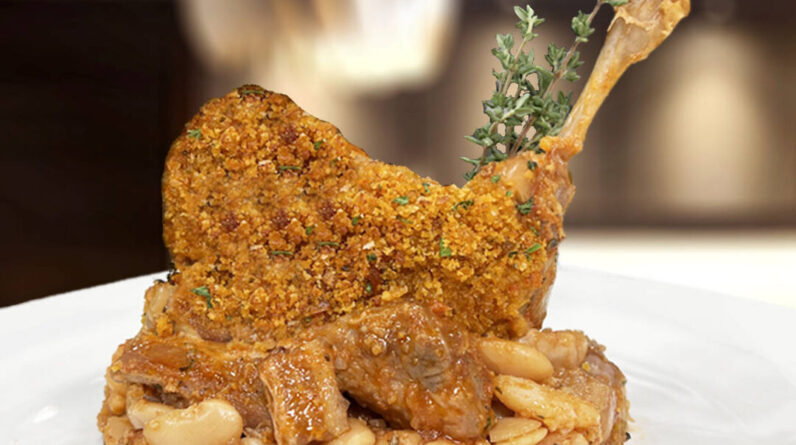
National Cassoulet Day is a celebration of this classic French dish, typically made with beans and various meats. Cassoulet is a hearty and flavorful dish that has a rich history and continues to be enjoyed by food lovers worldwide.
Originating in the south of France, cassoulet has been a staple of French cuisine for centuries. It is traditionally made with white kidney beans, pork sausages, and confit of duck or goose. The dish is slow-cooked to perfection, allowing the flavors to meld together and create a comforting meal that warms the soul.
On National Cassoulet Day, food enthusiasts and French cuisine lovers come together to celebrate this delicious dish. Whether enjoying it at a local restaurant or preparing it at home, the day offers a chance to savor the flavors and appreciate the culinary artistry behind cassoulet. So mark your calendars and get ready to indulge in this French delight on National Cassoulet Day!
The Origins Of Cassoulet
The Origins of Cassoulet
A journey through the history of cassoulet
Tracing its roots back to the Languedoc region in France, cassoulet is a hearty dish that has stood the test of time. Dating back to the 14th century, this slow-cooked casserole has its origins in the peasant communities of Southern France. While the exact origins are debated, it is believed that cassoulet was created as a way to use up leftover meats and beans, combining them in a satisfying and flavorful dish. Over the centuries, cassoulet gained popularity and became a standout dish in French cuisine. Its rich and complex flavors are a result of a combination of ingredients such as sausages, pork, duck, and white beans, cooked together in a ceramic dish known as a cassole. Today, cassoulet is celebrated on National Cassoulet Day and enjoyed by food enthusiasts around the world.
Captivating Flavors Of Cassoulet
Captivating Flavors of Cassoulet
A symphony of rich and hearty ingredients intertwine in the delightful dish known as Cassoulet. This iconic French stew originates from the Languedoc region and is traditionally prepared with dried white beans, tender meats, and savory herbs. The magic happens through the slow-cooking process, allowing the flavors to meld together into a harmonious masterpiece.
At the heart of Cassoulet lies duck, lamb, or pork, each contributing their own distinct taste. Morsels of succulent sausages add depth, while garlic and onions infuse the dish with aromatic notes. Carrots and tomatoes lend a touch of sweetness, while fresh herbs like thyme and parsley add a burst of freshness.
The result is a warming and satisfying meal that is perfect for chilly nights. Whether served as a comforting main course or a flavorful side dish, Cassoulet never fails to impress. So, celebrate National Cassoulet Day by indulging in a bowl of this gastronomic delight and savor the captivating flavors that make it so special.
Unveiling Classic Cassoulet Recipes
The celebrated National Cassoulet Day is a perfect occasion to immerse yourself in the rich culinary history of this hearty French dish. One of the most renowned renditions is the traditional cassoulet from Toulouse, which is often considered a culinary masterpiece. This sumptuous delight features a harmonious combination of ingredients including tender white beans, succulent meats such as duck confit, Toulouse sausages, and savory pork. The slow-cooking process allows the flavors to meld together, creating a delectable experience for your taste buds.
However, beyond the classic cassoulet from Toulouse, there are a myriad of regional variations that boast their own unique characteristics. In Castelnaudary, a neighboring town of Toulouse, the cassoulet is prepared with a slightly different twist, often featuring pork shoulder or lamb instead of duck. In Carcassonne, you’ll find a particular emphasis on fava beans and lamb, while in Tarbes, the dish is elevated with the addition of cèpe mushrooms.
The beauty of cassoulet lies in the versatility and creativity it affords. Each region prides itself on its own interpretation, resulting in a diverse range of flavors and textures. Whether you opt for the classic Toulouse version or venture into the intriguing variations, cassoulet promises a truly enchanting gastronomic experience.

Credit: chefjeanpierre.com
A Vegetarian Twist On Cassoulet
Bursting with flavors from seasonal vegetables and beans, this vegetarian twist on cassoulet is a delightful option for veggie enthusiasts. Reimagining the classic French dish, this version substitutes meat with an array of colorful vegetables to create a satisfying and hearty meal. The tender vegetables, such as carrots, celery, and bell peppers, are cooked until they are just soft while retaining their vibrant colors, adding both aesthetic appeal and delicious taste. The addition of white beans provides a creamy and protein-rich element to the dish, making it a well-rounded and nutritious option. Sprinkled with fragrant herbs and spices, every bite is a burst of flavor. Whether you are a vegetarian or simply looking to explore new tastes, this vegetarian cassoulet is a must-try!
Modern Takes On Cassoulet
On National Cassoulet Day, it’s the perfect time to explore the modern takes on this traditional French dish. Innovative chefs have been reinventing cassoulet by incorporating creative additions and alternative cooking methods.
One exciting trend is the addition of unexpected ingredients that bring new flavors and textures to the dish. Chefs are experimenting with ingredients like duck confit, sausage, lamb, and even seafood to create unique variations. These additions add complexity and depth to the cassoulet, making it a truly memorable culinary experience.
In addition to new ingredients, chefs are also exploring alternative cooking methods. While the traditional cassoulet is cooked slowly in a heavy pot, chefs are now using modern techniques like sous vide or pressure cooking to achieve the perfect texture and flavors.
Overall, modern takes on cassoulet provide a new twist to this beloved French classic. Whether it’s the addition of innovative ingredients or the use of alternative cooking methods, these new interpretations are sure to delight food enthusiasts on National Cassoulet Day and beyond.
Celebrating National Cassoulet Day
Are you ready to celebrate National Cassoulet Day? This culinary holiday allows us to embrace the joy of this delicious French dish and share it with our loved ones. Hosting a cassoulet-themed gathering is a great way to celebrate this special day. Gather your friends and family, and indulge in the rich flavors of this hearty stew.
Cassoulet is a traditional French dish made with white beans, various types of meat such as pork, sausage, and duck confit, along with flavorful herbs and spices. It is a slow-cooked dish that brings out the deep, complex flavors of the ingredients. The combination of tender meat, creamy beans, and aromatic herbs is simply irresistible.
To host your cassoulet-themed gathering, start by preparing a big pot of cassoulet. You can find numerous recipes online that cater to different dietary preferences and cooking skill levels. Serve the cassoulet in individual bowls or on a big platter for everyone to share.
Pair the cassoulet with crusty bread and a fresh salad to complete the meal. Don’t forget to set the mood with some French music and decor to transport your guests to the charming streets of France.
Celebrating National Cassoulet Day is a delightful way to appreciate the rich culinary heritage of France and create lasting memories with friends and family. So, gather your loved ones, savor the flavors, and enjoy this culinary holiday to the fullest.
Pairing Wines With Cassoulet
Pairing the right wine with your cassoulet can elevate your dining experience to a whole new level. The rich and hearty flavors of the cassoulet demand a wine that can complement and balance its intensity. For a classic pairing, opt for a red wine with bold flavors that can stand up to the robust flavors of the dish. Bordeaux, Rhône Valley reds, and Burgundy Pinot Noirs are excellent choices.
If you prefer white wines, look for medium-bodied options with good acidity. A white Burgundy or a Côtes-du-Rhône Blanc can provide a refreshing contrast to the cassoulet’s richness. Alternatively, if you enjoy sparkling wines, a Champagne or a Crémant can add a touch of elegance and effervescence to your meal.
| Wine Type | Recommended Wines |
|---|---|
| Red | Bordeaux, Rhône Valley reds, Burgundy Pinot Noirs |
| White | White Burgundy, Côtes-du-Rhône Blanc |
| Sparkling | Champagne, Crémant |
The key is to find a wine that complements the flavors of the cassoulet without overpowering them. Experiment with different wines to discover your personal preference. Cheers to finding the perfect pairing!
Beyond The Plate: Exploring Cassoulet Culture
On National Cassoulet Day, we delve into the rich cultural significance surrounding this iconic French dish. Beyond its gastronomic delights, cassoulet is deeply ingrained in festivals, folklore, and traditions.
Across the different regions of France, various versions of cassoulet are celebrated with fervor. The dish often takes center stage at festive occasions, where communities gather to honor their culinary heritage. In Castelnaudary, the birthplace of cassoulet, the annual Cassoulet Festival brings together locals and visitors alike for a mirthful celebration.
Cassoulet also wears the badge of cultural symbols. The three key ingredients—beans, sausages, and meat—represent the three estates of medieval society: the clergy, the nobility, and the peasantry, respectively. This symbolism emphasizes the dish’s historical importance, connecting generations of French society.
From its humble origins as a peasant dish to its elevated status as a comfort food enjoyed by all, cassoulet entwines history and tradition, captivating palates and hearts alike.
Cassoulets From Around The World
| Country | Unique Ingredients | Local Culinary Influences |
|---|---|---|
| Spain | Chorizo, morcilla, and saffron | Spanish paprika and flavors of the Mediterranean |
| United States | Andouille sausage and sweet potatoes | Cajun and Creole influences from Louisiana |
| Brazil | Feijoada – black beans, pork, and sausage | African and Portuguese influences |
| Mexico | Pork, beans, and peppers | Mexican spices and flavors |
Cassoulet, the traditional French dish originating from the Languedoc region, has inspired variations from around the globe. These international adaptations infuse unique ingredients, while incorporating local culinary influences.
In Spain, cassoulet takes on a Spanish flair with the addition of chorizo, morcilla, and saffron. The smokiness of Spanish paprika and flavors of the Mediterranean lend a distinct taste.
In the United States, particularly in Louisiana, cassoulet is influenced by Cajun and Creole flavors. Andouille sausage and sweet potatoes add a tangy and sweet twist to the dish.
Brazilian feijoada is a black bean-based cassoulet that incorporates pork and sausage, reflecting African and Portuguese influences.
Meanwhile, Mexican cassoulet features pork, beans, and peppers, spiced up with vibrant Mexican flavors.
The Cassoulet Controversy: Debates And Discussions
National Cassoulet Day is a celebratory event that often sparks debates and discussions among culinary experts and passionate food lovers. This popular French dish, originating from the south of France, has become a subject of controversy due to various aspects surrounding its ingredients and cooking techniques. One of the main areas of contention revolves around the traditional components of cassoulet, including the type of meat used, the inclusion of pork skin, and the use of confit or sausage. Some argue that a true cassoulet should adhere strictly to its original recipe, while others believe in adapting it to local ingredients and preferences.
The cooking techniques involved in preparing a cassoulet are another contentious issue. The long and labor-intensive process of slow-cooking the beans, meat, and vegetables together has led to numerous variations and shortcuts being developed. Purists argue that a cassoulet must be cooked slowly and patiently, while others advocate for quicker methods that still result in a flavorful dish.
These controversies continue to fuel passionate conversations and further research into the history and cultural significance of cassoulet. From the diverse perspectives of culinary experts to the personal experiences of food enthusiasts, each opinion adds to the rich tapestry of the cassoulet debate.
Frequently Asked Questions For National Cassoulet Day
Why Is Cassoulet So Special?
Cassoulet is special for its rich flavors and hearty texture. It’s a traditional French dish made with white beans, various meats like sausages, pork, and duck confit, and slow-cooked in a flavorful broth. The combination of ingredients and slow cooking process creates a truly delicious and satisfying dish.
What Exactly Is Cassoulet?
Cassoulet is a traditional French dish made with white beans, meat (typically sausage, pork, and sometimes duck), and herbs. It’s a rich and hearty casserole-style meal known for its flavorful combination of tender meat and creamy beans.
What French Town Is Famous For Cassoulet?
Carcassonne is the French town famous for cassoulet, a hearty dish made with meat and white beans.
When Should I Eat Cassoulet?
Enjoy cassoulet whenever you’re in the mood for a hearty, flavorful meal. It’s a traditional French dish that can be enjoyed year-round for lunch or dinner. Savor the combination of meat, beans, and herbs in this satisfying dish whenever you crave a comforting and delicious meal.
Conclusion
Celebrate National Cassoulet Day by indulging in this hearty French dish filled with rich flavors and comforting textures. Whether you’re a meat lover or a vegetarian, there’s a version of cassoulet to satisfy your cravings. From the tender confit duck to the savory sausage and creamy beans, every bite of this dish is a delightful experience.
So grab a bowl of cassoulet, sit back, and enjoy this delicious celebration of French cuisine.






